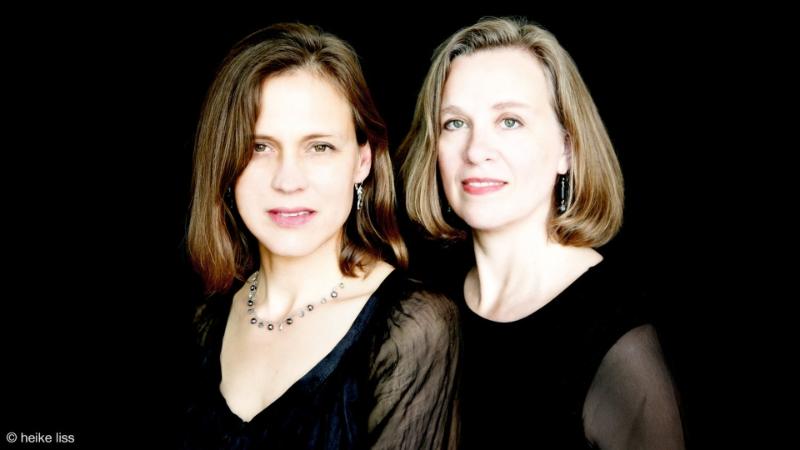The concert will feature related works for piano four-hands and two pianos by Conlon Nancarrow, Steve Reich and Gyorgy Ligeti.
- Date(s)
- March 7, 2024
- Location
- Harty Room, Music Building
- Time
- 13:10 - 14:00
Programme:
Conlon Nancarrow: Study for Player Piano #3b (arr. Amy Williams)
Steve Reich: Piano Phase (1967)
Nancarrow: Studies for Player Piano #6, 18 (canon 3:4), 15 (canon 3:4) (arr. Erik Oña and Yvar Mikhashoff)
György Ligeti: Self-portrait with Reich and Riley (with Chopin in the background) (1976)
Conlon Nancarrow: Study for Player Piano #3c (arr. Amy Williams)
Notes:
Discouraged by the lack of acceptable performances of his music, Conlon Nancarrow (1912-1997) turned to the player piano in the late 1940s. His exhaustive exploration of this unusual medium resulted in a series of approximately fifty Studies, both highly idiomatic and utterly original. In 1998, the Duo initiated a large-scale transcription project of these works, which includes thirteen Studies arranged for four-hands, one for two pianos, and one for two pianos, eight-hands. Missing from the original realisations are the harsh sound of the leather and metal hammers of Nancarrow’s pianos, the register differentiation of the upright instruments, and the resonant acoustics of the composer’s cement studio. The transcriptions are, however, as faithful as they could be to the original pieces in terms of actual pitches, rhythms, and tempos. Many salient traits of Nancarrow's mechanical music, in particular his rhythmic language, were strongly influenced by jazz as well as African and Indian musical traditions; he also considered early Stravinsky and Bach as strong musical inspirations. Canonic procedures, particularly those in which the voices are in different speeds, are used in nearly all the Studies, ranging from various kinds of imitation to strict canons.
The canonic effects that Nancarrow explores also find their way into Steve Reich's seminal minimalistic work, Piano Phase. Departing from a 12-note pattern in absolute unison, Reich puts in motion a process of separation that creates quasi hypnotic results of gradual transformation. The Self-portrait of György Ligeti’s Three Pieces for Two Pianos is an homage to his once musical kinship with Reich and also Terry Riley. The Presto at the end of this movement alludes to the finale of Chopin’s B minor Sonata, an early precursor of “quintessentially minimalistic music,” according to the composer. On many occasions, Ligeti professed a deep admiration for the music of Conlon Nancarrow, describing it as “something great and important for all music history! His music is so utterly original, enjoyable, perfectly constructed, but at the same time emotional.” Although, the Three Pieces precede Ligeti’s encounter with Nancarrow’s work, there are many compositional traits that clearly resonate with Nancarrow’s Studies: the pervasive use of canons/phasing, the play with unpredictable processes of repetition and change, and extremely fast speeds (the tempo indication is “as fast as possible—or even faster”).
The Bugallo-Williams Piano Duo has been presenting innovative programs of contemporary music throughout North America and Europe since 1995. Helena Bugallo and Amy Williams have premiered dozens of works, many of which were written especially for the Duo, and they have worked directly with such renowned composers as David Lang, Tania Léon, Louis Andriessen, Lukas Foss, Steve Reich, Marcos Balter, Bernard Rands, Betsy Jolas and Kevin Volans. The Duo has been featured at the Warsaw Autumn Festival, Muziekgebouw aan’t IJ (Amsterdam), Palacio de Bellas Artes (Mexico City), Miller Theatre, Le Poisson Rouge and Symphony Space (New York City), CAL Performances (Berkeley), Wittener Tage für neue Kammermusik (Witten), and Ojai Festival (California), to name a few. As part of their mission to expand the repertoire for piano duet, the Duo has undertaken an extensive transcription project of the Studies for Player Piano by Conlon Nancarrow. This resulted in a critically acclaimed recording of Nancarrow’s music for piano duet and solo piano, released by Wergo in 2004. They have also recorded the music of Jorge Liderman, Erik Oña, Feldman/ Varèse, Ginastera (Neos, 2010), Amy Williams, Kurtág, Bartók, and Stravinsky.

